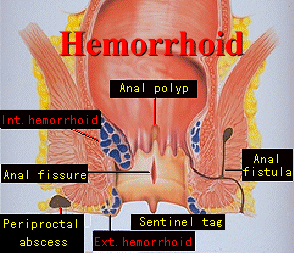Main Body of Hemorrhoids
- There are blood vessels like mesh nets around the anus and the lower edge
of the rectum. The main body of hemorrhoids
is the wens which swelled up into a wen condition
(varices). Symptoms like bleeding from varices
and swelling of thrombosis inside the vein
appear.
Internal and external hemorrhoids
- Internal hemorrhoids develops under the mucous membrane
at the lower edge of the rectum, and external hemorrhoids develops under
anal epithelium of the anus (outside the dentate line). Internal hemorrhoids
bleeds but does not hurt; external hemorrhoids does not bleed but hurts
badly when swollen.
Causes of hemorrhoids
- When human beings started to walk upright, the position
of the anus became lower than the heart, and the pressure of hemorrhoidal
vain became higher. The fact that animals on four feet do not suffer from
hemorrhoids proves this point. Thus, standing or sitting in the same position
for a long period of time is thought to be a cause of hemorrhoids. Straining
too hard to defecate worsens hemorrhoids, too.
- Constitution: The hemorrhoidal vein of people
whose tissues around hemorrhoidal vein are
weak expands easier when applied pressure
and have a higher possibilty of developing
into a varix which is the main body of hemorrhoid.
Therefore it is thought that the constitution
to develop hemorrhoids easily is hereditary.
- Aging: The tissues which support the anus weakens with
age, and hemorrhoids tend to slip out of the anus more easily.
- Etc.: Consuming too much alcohol or irritating
food like mustard or pepper worsens the bleeding
and the swelling. Pregnancy and childbirth
also worsen it for women.
Degrees of hemorrhoids
| 1st |
 |
Bleeding is the main symptom, and there is no anal
prolapse. |
| 2nd |
 |
Prolapses when defecating, but comes back inside the
anus when finishing defecating naturally. |
| 3rd |
 |
After the prolapse, it does not return inside without
pushing it with your fingers, etc. |
| 4th |
 |
It is always outside the anus, even without any defecation. |
Symptoms of hemorrhoids
- External hemorrhoids: hemorrhoids outside the
dentate line. The most frequently seen is thrombus formation, whose main
body is the thrombosis (clot) which developed in the veins of the external
hemorrhoids. A lump accompanied by severe pain forms suddenly outside the
anus, but it rarely bleeds. When the skin covering the part which became
a thrombosis breaks, though, the blackish red thrombosis solutes and produces
a little amount of blood. The thrombosis will deflate and the pain will
cease quickly. Consevative therapy( ointment, painreliever, bath) also
absorbs thrombosis gradually and makes it better. If the thrombosis is
large and you want to get rid of it at once, you can do it by having an
incision under local anesthesia and removing it.
- Internal hemorrhoids: Hemorrhoids inside the dentate line. There
is bleeding but no pain. Prolapse of the
anus occurs when the supporting tissues around
internal hemorrhoids weaken and slip outside
of the anus.
Treating hemorrhoids
- Bleeding and pain: Consevative therapy is chiefly
done. Keep the anus warm and clean. Try to control your bowel movements;
avoid constipation or diarrhea. When the movements cannot be regulated
by keeping a good diet, use antiflatuent or laxatives. Also add suppository
and ointment to the treatment, and painreliever and antiinflammatory depending
on your condition.
- Prolapse of the anus: A
surgery will be needed to treat this. But because hemorrhoids is a
benign illness, the adaptability of a surgery is decided upon the will
of the patient to want to treat it or not. It is not fit to do surgery
on a patient who does not mind the prolapse much.
|

